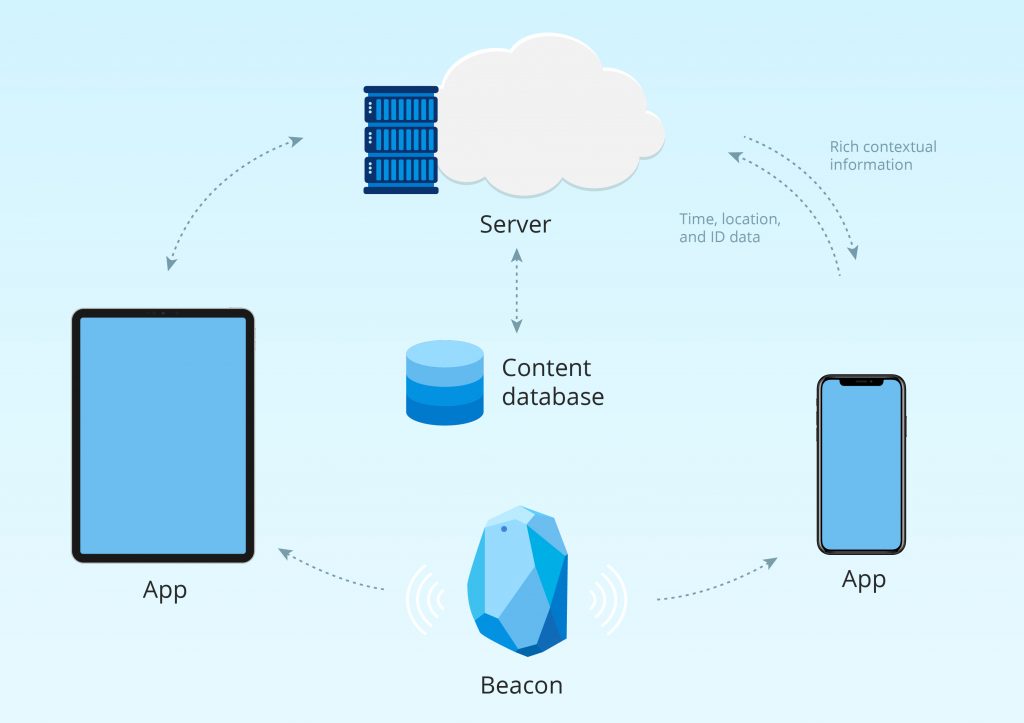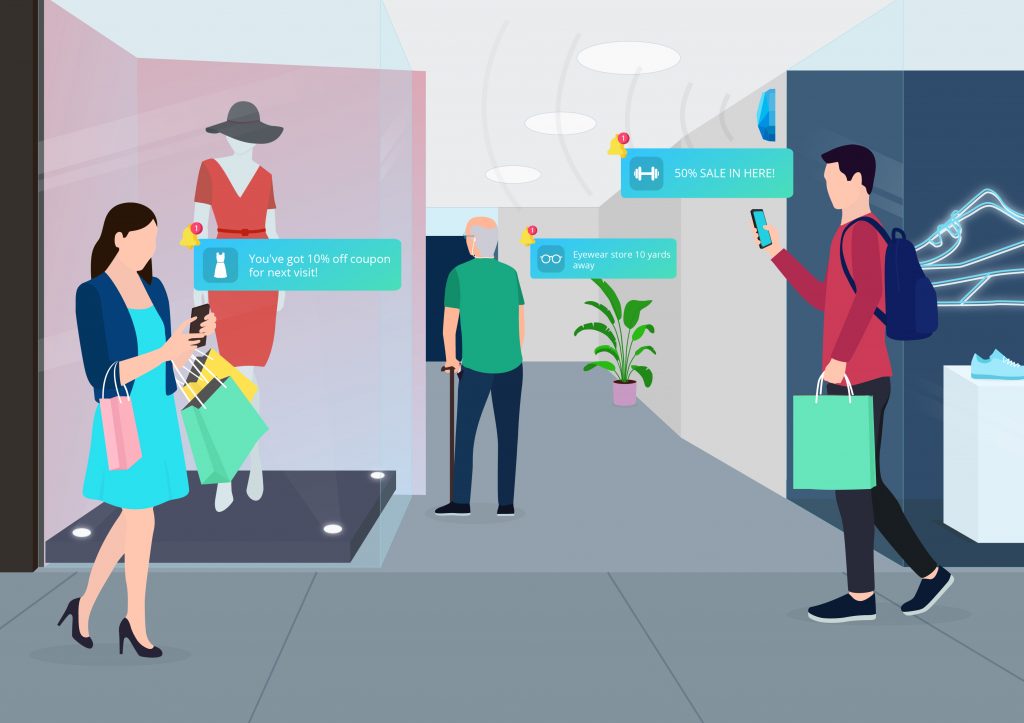How Do Beacons Work for Businesses?
Beacons are small, simple devices. You’ve probably spotted them at airports or Macy’s. A beacon transmits simple data to smart devices nearby. Sounds unimpressive, yet the technology has the potential to transform the marketing landscape and solve various issues across different industries. According to Global Market Insights, beacon tech market is about to surpass $25 billion by 2024.
This article focuses on how beacons can assist business owners, contribute to successful marketing strategies, and improve the overall user experiences. (If you wonder ‘What is beacon technology all about?’, there are some beacon tech basics first.)
How do beacons work?
Each beacon device contains a central processing unit, radio, and batteries. Additionally, they may have accelerometers, temperature, light or motion sensors, and other add-ons. Beacons also differ in size, battery life, and resistance to water, dust, etc. However, the primary function is always to transmit a signal.
Bluetooth technology, which is available in 90% of the phones, provides the infrastructure for the beacon ecosystem. Bluetooth Low Energy (BLE or BTLE) facilitates small periodic transfers of data over short distances. ‘Bluetooth Low Energy’ literally means a lower energy consumption. Thus, a BLE beacon can be actively used for longer periods on tiny coin-cell batteries. It’s important because a beacon has to transmit its identifier several times per second.
The identifier is an ID which smart devices recognize as unique to the beacon. Each ID is registered in a dedicated application. Its numbers and letters have little meaning on their own; it’s entirely up to the beacon mobile app to recognize what an ID means. BLE communication consists primarily of broadcasting small packets of data called ‘advertisements.’
Bluetooth-enabled devices within a broadcasting distance of a beacon pick up its signals. If a device has a dedicated app installed, it recognizes the identifier and links it to an action or piece of content in the cloud. The latter triggers the required app action.

Thus, for using beacons, the following are required:
- at least one beacon device
- an application that supports beacon technology and is installed on a mobile OS supporting one of the beacon standards
- the user’s permission
Regarding the beacon standards, two configurations rule the market currently. In 2013, Apple created iBeacon technology. It marked the start of contextual experiences delivered via indoor positioning. In 2015, Google came out with a platform-agnostic alternative, Eddystone.
Beacons usually support both protocols. The main difference between them is the unique IDs. iBeacon’s ID has one advertising packet which contains three different components whereas Eddystone has several different kinds of beacon packets.
How do beacons work in everyday life? Most smartphones, iOS 7 or Android 4 and higher, support beacon technology. Single or multiple beacons enable an application or platform to locate each user in a physical space accurately. A typical scenario is as follows.
A person carrying a smartphone enters a space with installed beacons, e.g., retail store. A beacon sends a coded message to the smartphone. It awakens the brand or third-party (e.g., shopping mall’s) mobile app which communicates the data to the server. The server triggers an appropriate action by the app, such as highly contextual, meaningful in-store notifications. Thus app owners can transmit any information to mobile devices within a beacon’s range.
The unique beacon signal doesn’t change often, but the content behind it does. The store may be advertising sales from one season to another. Once a specified date comes around, they alter the content. Storing data in the cloud means it can be updated almost instantly. The beacon sends the same unique ID, but the receiver will trigger different content-related information from the app. It will serve up any new seasonal offers or deals promoted to customers.
Beacons are not tracking people, just trying to connect their location to the app. The rest is up to the owner who has programmed it. They can ‘teach’ the app how to react to a beacon signal. Beacons also can be programmed to perform various functions. This allows companies to customize the way their users receive and digest information.
Some beacons come with mobile app development frameworks. These tools enable a business to build an application to go along with the device and set up an indoor positioning system. Online platforms like Kontakt.io dashboard let business owners manage, configure, and update their beacons. From there, they can use a content management system to associate links, images, videos, and texts with individual beacons.
Because a beacon signal can trigger so many different things, the applications and potential of beacon technology seem limitless.
What is beacon technology offering to businesses?
Beacons improve the overall user experience
Beacons help streamline operations, automate actions, trigger events, and remove friction from day-to-day activities. For example, Amazon uses beacons, along with cameras and sensors, in cashier-less grocery stores. Computer vision, sensor fusion, and machine learning power the checkout-free shopping experience. Users need the free Amazon Go mobile app to enter the store. While they’re shopping, Amazon Go’s technology automatically detects what they take from the shelves and adds the items to a virtual cart. No checkout is required; the items automatically get charged to the shopper’s Amazon account when they’re leaving. The shoppers don’t have to wait in lines and interact with human cashiers.
In 2017, UK’s Gatwick Airport installed around 2,000 beacons for indoor navigation. In 2018, they launched an award-winning app with an augmented reality section. The beacons facilitate AR wayfinding and the provision of personalized, real-time flight updates, gate information, and check-in and security queue times to each app user.

Image source
Provision of navigation tips and spot-on information is useful in a museum, concert venue, theme park, etc. Some apps use beacons to help drivers search for a parking space. When they’re back, the app will help to find their car.
Visually impaired passengers would benefit from micro-navigation enhanced with beacons. A beacon tech-integrated app can help them navigate public transportation. The app might be telling them how far away they are from a bus stop, when the bus will arrive, and so on.
Video USB beacons are plugged into TVs to deliver visual information. For example, when a customer approaches one in a restaurant, a screen would display personalized offers. Such experiences not only save time. They spice up a customer journey with fresh memorable moments.
Alternative-spaces team had integrated beacon technology into the Wine Picker mobile app for iOS and Android. The app features a sophisticated proprietary wine selection algorithm to pick the best wine match for the dishes ordered. Partner restaurants install BLE beacons. When a user visits one of them, the beacon connects with the app. Based on a certain logic, the app notifies the user, encouraging them to find the best wine the restaurant has to offer. The valuable feature took a fortnight to realize.
Beacons can assist in understanding your audience. The devices support applications in gathering customer data which helps tailor shopping experiences and improve the connection to consumers throughout the process. Combined with e-commerce stats, it helps to adapt product listings and in-store layout, perfect the customer journey, and develop future marketing campaigns.
Beacons improve marketing
Beacons have great potential in proximity marketing and location-based technology. Even a simple alert will inform customers that your shop is nearby. Messages about discounts, rewards, and product recommendations based on their location should be more effective. The location-based technology can personalize your out-of-store marketing and add another dimension to your digital strategy.

With the beacons’ greater accuracy, you can gather more reliable information on how your customers are moving throughout your shop. At a retail store, beacons installed in mannequins can track how long customers were looking at an item and their method of purchase. The info would help retailers customize their marketing strategies.
When firms connect the beacon signals to their Google Ads accounts, they can gain useful insights into the searchers’ offline activities and track in-store visits. By logging actual store visits from the search ads, beacon technology lets understand the impact and effectiveness of the ads. When firms gather data on marketing activities, they can better evaluate their effectiveness and adapt the marketing efforts accordingly.
Beacons help at the back-end of businesses
Indoor positioning systems installed throughout warehouses and storage locations are providing context, indoor and outdoor navigation, and indoor tracking. In manufacturing and logistics, managers need to know exactly where goods are at any given time. By attaching BLE beacons, they can always track assets accurately and even see the information from previous days or weeks. Delivery employees can check on items in a vast warehouse faster and more conveniently. The employees’ mobile devices can serve as a pass.
Beacons can be used to track people, e.g., patients or doctors in hospitals during emergencies. Companies and apps that utilize emergency alerts can use BLE beacons to detect a person’s location more accurately. Automatic alert notifications sent to employees improve safety. Beacons paired with geofencing can add an extra layer to data security.
Beacons are economically effective
BLE beacons are cost-effective, easy to set up and manage, and adaptable. They offer a cheaper and lower-maintenance alternative to Wi-Fi for indoor navigation.
To Recap
Beacons are cheap, simple, and barely noticeable. However, beacon technology is a potential game-changer in retail, hospitality, travel, transportation, and other industries. Beacons are not only becoming the foundation and major driver of the Internet of Things. Another paradigm shift is expected in the way companies operate, serve their customers, and communicate with consumers. Online-to-offline attribution modeling and user-focused proximity marketing potential are only some of the business advantages the technology can offer.
Beacon technology keeps developing better hardware, new capabilities, and diverse solutions. As the technology matures, other sectors will follow in understanding how it can aid their day-to-day activities. The number of entities that adopt the technology will be growing.
If you’ve read the article, hopefully, you won’t be asking ‘What is a beacon?’ or ‘What do beacons do?’ any longer. You might instead want to utilize beacons together with an enterprise or e-commerce application. If you are contemplating a beacon or another IoT solution, or a custom mobile app for iOS or Android, don’t hesitate to contact Alternative-spaces!
Content created by our partner, Onix-systems.
 Home
Home